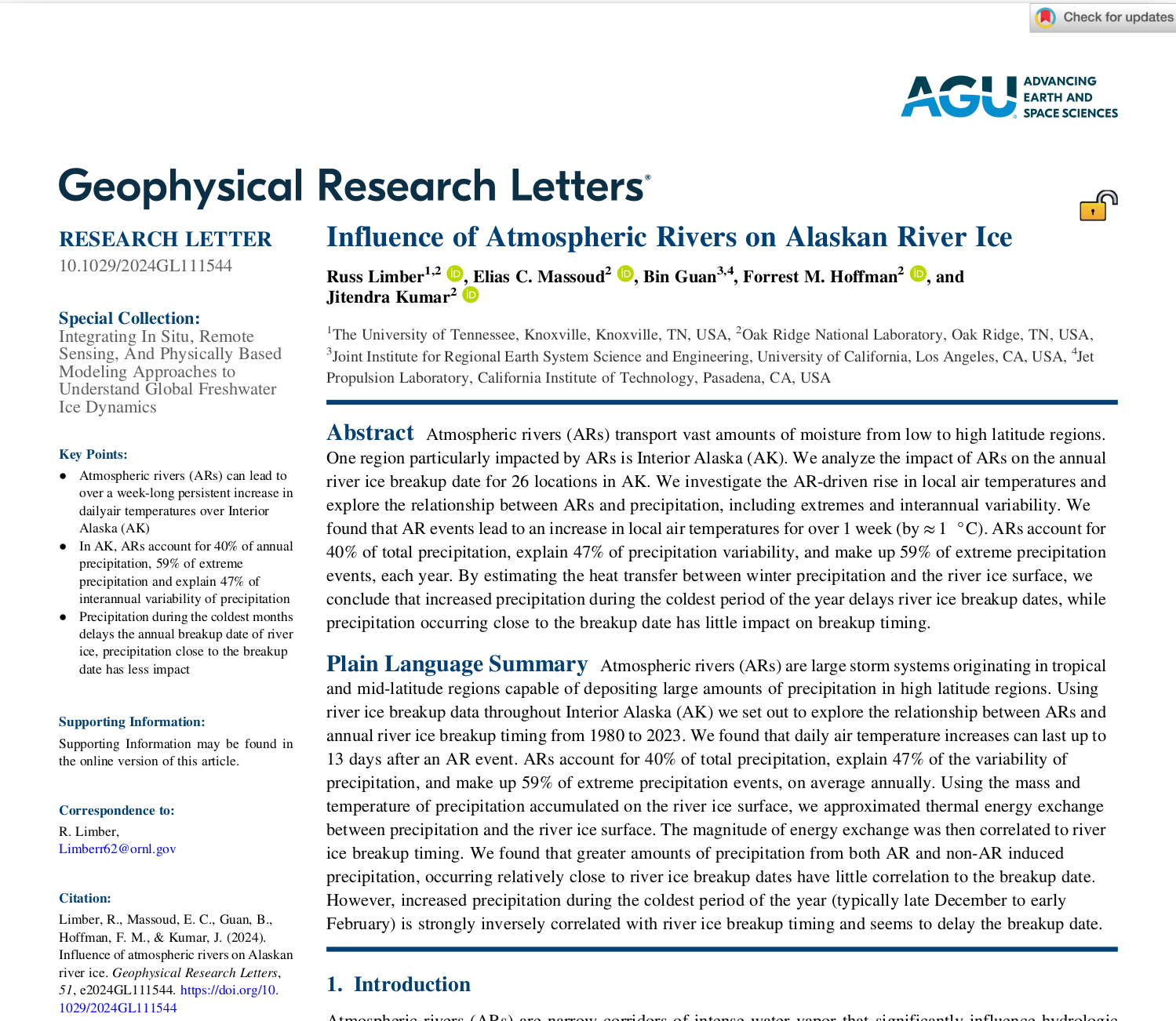AR Influence on River Ice

Limber, R., Massoud, E. C., Guan, B., Hoffman, F. M., & Kumar, J. (2024). Influence of atmospheric rivers on Alaskan river ice. Geophysical Research Letters, 51, e2024GL111544. https://doi.org/10.1029/2024GL111544
Precipitation during the coldest months delays the annual breakup date of river ice, precipitation close to the breakup date has less impact. The Science
Atmospheric rivers (ARs) are large storm systems originating in tropical and midlatitude regions capable of depositing large amounts of precipitation in high latitude regions. The researchers identified 26 locations across Alaska USA that had a complete or near complete time series of observed annual river ice breakup dates from the National Weather Service, Alaska-Pacific River Forecast Center. They then proceeded to perform a correlation analysis comparing the timing of the annual river ice breakup and the estimated thermal energy exchange between the river ice surface and precipitation using Daymet meteorological data. In addition, the authors used statistical analysis to determine: the magnitude and duration, that ARs influence near surface air temperature; the proportion and interannual variability of total precipitation, that ARs account for.
The Impact
Using a paired t-test with an AR event as the treatment, it was found that ARs increase daily minimum temperature by as much as 1.3 °C (assuming a 3 day window) and increase maximum daily temperature by as much as 0.67 °C (assuming a 4 day window). This temperature increase brought on by ARs appears to persist for about a week in both the minimum and maximum daily temperature variables with a more extreme impact in both magnitude and duration in daily minimum temperature. Using linear regression, it was found that ARs explain 47% of interannual variability. From exploratory analysis, ARs account for 40% of total precipitation annually and make up 59% of extreme precipitation events (top 5% of precipitation events). From the Wilcoxon rank-sum test, ARs tend to account for far greater precipitation than non-AR related precipitation. Using an estimate of heat transfer between precipitation and the river ice surface, it was found that all precipitation (AR or non-AR) happening during the coldest time of the year (typically between late November and early February) have the greatest absolute correlation with breakup timing, showing a strong inverse relationship. Precipitation occurring closer to the breakup had little correlation.
Summary
Leveraging river ice breakup data throughout Interior Alaska (AK) the authors set out to explore the relationship between ARs and annual river ice breakup timing from 1980 to 2023. They found that daily air minimum air temperature increases can last up to 13 days after an AR event. ARs account for 40% of total precipitation, explain 47% of the variability of precipitation, and make up 59% of extreme precipitation events, on average annually. Using the mass and temperature of precipitation accumulated on the river ice surface, the authors approximated thermal energy exchange between precipitation and the river ice surface. The magnitude of energy exchange was then correlated to river ice breakup timing. It was found that greater amounts of precipitation from both AR and non-AR induced precipitation, occurring relatively close to river ice breakup dates have little correlation to the breakup date. However, increased precipitation during the coldest period of the year is strongly inversely correlated with river ice breakup timing and seems to delay the breakup date.